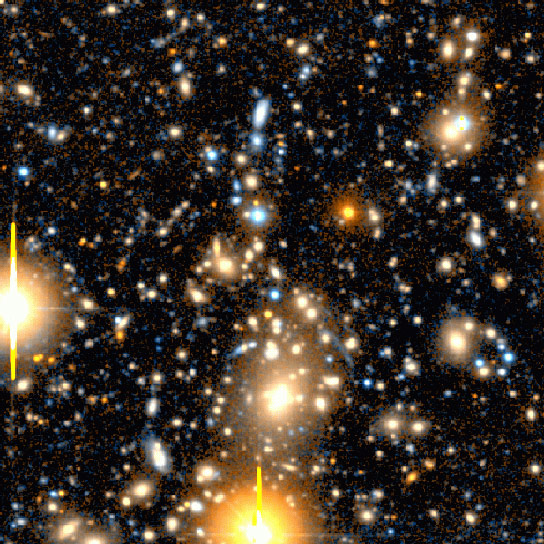
Using the Chandra X-ray Observatory and the ALMA radio array, astronomers have detected a flow of about ten billion solar masses of rapidly moving molecular gas in galaxy cluster Abell 1835.
Galaxy clusters are groupings of several to thousands of galaxies. Most galaxies are members of a cluster. In our own case, the Milky Way is a member of the “Local Group,” a band of about fifty galaxies whose other large member is the Andromeda galaxy about 2.3 million light-years away. The closest large cluster of galaxies to us is the Virgo Cluster, with about 2000 members; its center is about 50 million light-years away. The space between all these galaxies is not empty, but is filled with hot gas whose temperature is of order ten million kelvin, or even higher.
The clustering of galaxies influences how any particular member galaxy will evolve. Current models of galaxy clustering suffer from several glaring omissions. One relates to the fate of its hot, X-ray emitting gas. In the cores of clusters the gas is heated by jets from supermassive black holes, supernovae (the explosive deaths of stars), and other processes. The mystery is why this hot gas does not cool and then sinks towards the center of the cluster. The common surmise has been that outflowing jets from supermassive black holes, or other kinds of feedback, inhibit the formation of such “cooling flows,” but establishing the details of this mechanism has been elusive.
CfA astronomers Brian McNamara and Paul Nulsen, together with their colleagues, have examined the flowing gas in the bright cluster Abell 1835. They used the Chandra X-ray Observatory to image the very hot gas in the cluster, and the ALMA radio array to measure for the first time the motions of the cooler, abundant carbon monoxide gas. The astronomers detected a huge flow: about ten billion solar masses of rapidly moving molecular gas. The questions are whether this gas is moving outward or inward, and what causes the motion.
The astronomers conclude from the distribution of the gas motion that it is almost surely moving outward – inward movement would tend to speed up the gas near the gravitational center. As for the cause, this cluster also has about fifty billion solar masses of molecular gas from which it is making new stars at a rate of about 100-180 per year (a very high rate when compared for example to the Milky Way rate of a few per year). The supernova explosions produced by these new stars, however, appear to not be quite enough to account for the motions observed. Instead, the scientists conclude that the outflow is driven by broader outflows powered by the jets from the active black-hole nuclei. The new results imply that jet-heated, X-ray emitting gas may be responsible in many cases for driving vast amounts of molecular gas out of galaxies and into the intergalactic medium.
Reference: “A 1010 Solar Mass Flow of Molecular Gas in the Abell 1835 Brightest Cluster Galaxy” by B. R. McNamara, H.R. Russell, P. E. J. Nulsen, A. C. Edge, N. W. Murray, R. A. Main, A. N. Vantyghem, F. Combes, A. C. Fabian, P. Salome, C.C. Kirkpatrick, S. A. Baum, J. N. Bregman, M. Donahue, E. Egami, S. Hamer, C. P. O’Dea, J.B.R. Oonk, G. Tremblay and G.M. Voit, 25 March 2014, The Astrophysical Journal.
DOI: 10.1088/0004-637X/785/1/44
arXiv:1403.4249
Never miss a breakthrough: Join the SciTechDaily newsletter.